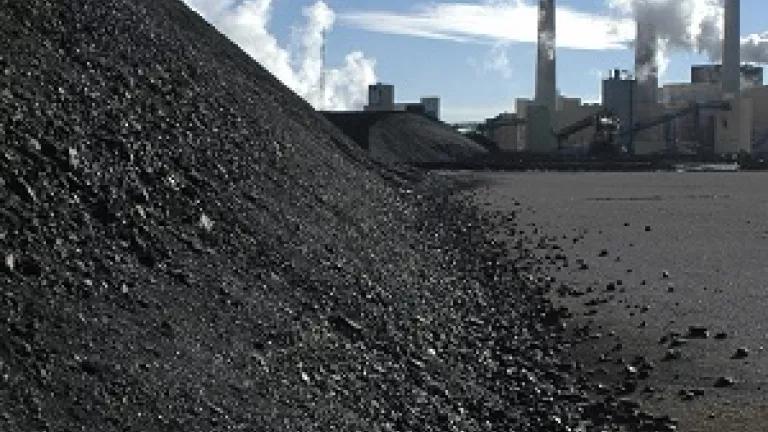
The electric power industry is changing, driven by many factors. Leading the
way are quintessential marketplace factors like fuel price changes and the emergence of new technologies. Another factor in the mix is the implementation of long-overdue pollution standards that are essential to protect public health and prevent dangerous climate change.
But some in the power industry are pushing a narrative that blames the U.S. Environmental Protection Agency (EPA) for every change happening to them. Don’t fall for it.
A case in point is a recent Bloomberg article that largely blames environmental standards for forcing many coal plants to close, in turn causing higher electricity prices across the country. Let’s look at the facts.
Most of these old and dirty coal plants were driven off the cliff by the marketplace – cheaper power from newer natural gas plants, wind and solar, and cheaper energy savings through investments in efficiency.
Some coal plants teetering on the brink of economic failure could be pushed over the edge by the need to comply with pollution standards to address the harms caused by those plants’ soot, smog, mercury, and carbon footprint. But that’s a far cry from the blame-EPA storyline in Bloomberg’s article.
Looking ahead, the surest way for power companies to provide their consumers with affordable and clean electricity will be to adopt strategies that emphasize energy efficiency (consuming less energy) and renewable resources like wind and solar power (with zero fuel cost and carbon emissions).
Trimming fat from the grid
One telling statistic in the Bloomberg article: most of the power plants slated to close by the end of 2015 ran an average of only 38 percent of the time! That’s because they were expensive to run and weren’t needed to satisfy consumer demand. As the nation’s electric grid operators have confirmed, nearly all of those plants can be closed without triggering electricity service reliability concerns.
It’s especially odd to see some plants’ current problems blamed on standards to reduce their pollution that won’t take effect for another half-decade. With proper planning, there’s no reason for future carbon emissions standards to cause power shortages.
Power prices matter, but people pay bills, not prices
The main focus of the Bloomberg report is on power prices. The story harkens back to high power prices seen during last winter’s Polar Vortex. No question, power prices spiked for a few days last winter, when many regions of the country experienced extreme cold and hit all-time records for winter electricity demand. Many coal and gas plants struggled with mechanical and fuel supply issues – and some plant owners needed to pay much more than normal for the fuels to meet peak power demand. Grid operators are now taking steps to avoid these problems in time for next winter. Notably, wind power and demand response (paying customers to shift or reduce their electricity use) helped to alleviate grid strain and prevent blackouts during the Polar Vortex.
Looking to the future, the Bloomberg article quotes Phil Moeller, one of the Federal Energy Regulatory Commission (FERC) commissioners, for the proposition that prices are certain to rise in the next couple of years. Even if he is right in the short term about power rates/prices, customers pay bills, not prices. If we adopt smart policies to optimize our energy use, overall customer electricity bills can decrease even if the price per kilowatt-hour goes up.
Energy efficiency - more bang for the buck
How? Your electric bill depends on two factors: how much each kilowatt-hour costs, and how many kilowatt-hours you use. By using energy more efficiently – by adopting more efficient appliances, lighting, heating and cooling systems, insulating homes, etc. – customers can cut how many kilowatt-hours they need, and their total bills can go down. Power companies and their regulators have the opportunity – and the responsibility – to make this happen.

Using energy smarter will help consumers by lowering energy consumption while costing less than half as much as building new power plants. Because EPA’s Clean Power Plan proposal calls for states to be credited for energy efficiency improvements in all sectors of the economy, EPA expects that electricity bills will drop as a result -- by about 8 percent. For the average customer, that represents an annual savings of about $100.
Wind and solar energy – freedom from fuel costs
For power that is consumed, wind and solar energy will have a critical role in reducing prices because they have no fuel costs. Power plants in many areas of the country are “dispatched” continuously throughout the day to meet demand, from least cost to most expensive to operate. All plants running at any given time are paid the “market clearing price,” pegged at the cost of the most expensive plant on the system at that time. For coal- and gas-burning plants, fuel costs account for up to 90 percent of the wholesale price of electric power. As more renewable energy comes onto the grid, it will reduce the demand for more expensive fossil power, which in turn lowers the market clearing price for all power plants and saves consumers money.
The “free fuel” savings can be very large. In Texas, wind energy saved consumers $736 million in 2013. The savings will only get better as we integrate more wind and solar power into the electricity mix. At least 15 studies by power grid operators, states, and academic experts have found wind energy drives electricity prices down while cutting carbon pollution. A study earlier this year by the nation’s largest grid operator reports that generating 30 percent of the total electricity in its region with renewable energy would save consumers up to 30 percent, even after factoring in more transmission lines necessary to bring power to consumers. Carbon dioxide emissions also fell 41 percent.
The triumph of common sense
Energy efficiency – cheaper than new power plants. Renewable energy – zero fuel costs and dependable power. No carbon or toxic pollution from these cleaner resources. Strong environmental standards and affordable clean energy technologies are both climate and consumer-friendly and point the way to a more reliable and sustainable electricity future.

